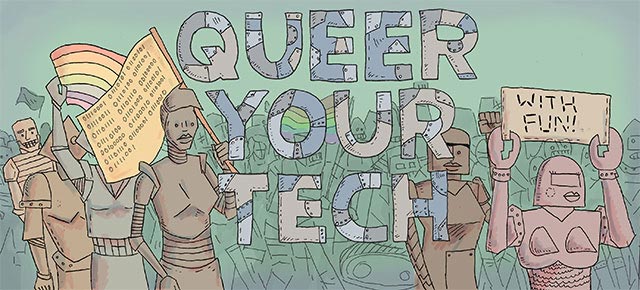
Hello webbie-queers! Thus continues our “So You Want to Make a Website” series, a series encouraging you (yes, you) to use the tools available to you on the web to take control of your own narrative/business/creative life/whatever. We’ve covered what you’re going to make, how you’re going to make it, a small digression in favor of learning to code and now, the domain name. Domain names are the addresses you type in the URL bar that will eventually take you to your website. There are about one million options for domain name ownership, so let’s just dive in.
No Domain Name
Since you’ve already chosen your website builder or platform, you’ll know if you’ve picked one that grants you a domain name of sorts — usually they look like [your-website-title].wordpress.com or [your-blog-title].tumblr.com. They’re these lovely little subdomains that you automatically obtain when building your website or blog on a great many services out there. There’s an upside to this — it’s free. No need to purchase anything, just get that website up there and go. The downside, though, is that it’s generally thought to be unprofessional — people may take you less seriously with a .wordpress.com or a .tumblr.com at the end of your name or title. Or they may not! That’s the thing, is it’s a crap shoot. Plus, I liken using the subdomains that come with a service to wearing a tee-shirt emblazoned with the logo of a large corporation — you become a walking advertisement for whatever service you’re using, and that detracts from your personal brand. There’s also the perception that you take yourself less seriously when you use a free subdomain, or that you are less confident in the project you’re taking on, like you aren’t willing to put your resources where your mouth is.
Now of course, we all know that’s not true. Sometimes, especially in marginalized communities, the resources just aren’t to be had up front. So if you are a person who wants to put a website up and can’t or doesn’t want to purchase a domain name to go along with it, take a deep breath and make your thing anyway. Just know that you might be fighting a little bit of conscious or unconscious bias, and that (much like women in STEM fields) your content might actually have to be better than competitors’ or peers’ content to be considered equal. It’s not fair, but it’s how it is for right now. Luckily, though, there are many domain names that are super affordable!

YourName.com
Purchasing your name as a domain name is something I feel like most people who ever in their lives intend to have a website should do right away — grab it before someone else does. And grab iterations of your name too: I own two (aeosworth.com and aliosworth.com). Also, though, pay attention to how your domain name sounds when you say it out loud, or any weird words that pop out when your name is written with no spaces. I don’t own alisonosworth.com, for instance, because all I can see out of that domain name is Nosworth. And I’m sorry, but I don’t want to be Nosworth.
YourName.com websites work best for people who work for themselves as freelancers — writers, actors, designers. Basically, if networking events for you are industry parties where you are introducing yourself by your own name and you are the only person who’s going to get hired if that goes well, you might want to consider this kind of domain name. The upside of these domain names are that they’re easy to remember — if someone knows you, they know how to find you on the web as well. It’s also easy to find you when you’re mentioned by name on other websites — YourName.com works especially well when you have bylines elsewhere as well. Google likes a YourName.com because it’s likely to come up early in the search results when people search, well, your name. The pros here are endless.
My one and only big con, here, is that it can feel tempting to distill your personality into a persona. If your digital life is encompassed by your actual, real name and you are marketing yourself, it feels easy to become a 2D Tumblr person in real life. And that’s not what you want. To quote Whitman, “I contain multitudes.” It’s easy to overcome this drawback by just knowing that this exists and avoiding it.
So where do you go to see if your name is available, and how much it will be per year (because yes, domain names are essentially subscriptions)? That means that there’s some turnover and if someone else has your name and never uses it, chooses to let it go back to the soil (so to speak), then you can grab it too.
Namecheap is a good option for purchasing domain names; it’s fairly user-friendly and easy to get right to the page and type in YourName.com (the search bar is right there). On Namecheap, I searched a colleague’s name and came up with the price $10.69 per year (heh. 69).

YourBusiness/BlogName.com
Using a name other than your own is good for when your website represents an entity, like a business, or any organization where there are multiple people involved. If you already have a business name, great! Very little thought needs to take place here, though I do recommend following the same steps as when you’re looking at your own name: are there any untoward words that occur when your business name is typed without spaces? If so, never fear! A good way to combat that without having to change your pre-existing business name around is by adding a hyphen. A good example of a hyphenated domain name is A-Camp.org.
If you don’t have a business or collective blog or news site or whatever name yet and this is your first foray into building such a thing, you’ll need a name. For this I have a tried and true exercise: mind mapping. Draw a large bubble in the middle and leave it blank. Then branching from that bubble, create new bubbles with all the things you want your site to do and be. These can be things like topics you want to cover (“personal essays,” “queer news specific to Austin,” “videos of baby goats”) or words that describe the vibe you’re going for (“edgy,” “honest,” “academic,” “colloquial”). I find the second category bubbles to be almost more helpful — it’s easy to name something what it is, but it’s harder to come up with a name that conveys how it is. Both are important, but it’s the how that’s going to distinguish you and really make your domain name a valuable piece of your whole brand and experience. I also recommend doing this exercise with a thesaurus handy—there might be some key words (not keywords, I mean words that unlock a whole new path for you) that you’re overlooking.
There are a few times, by the way, that I recommend coming up with a brand name or blog name other than your own even if you are a one person show.
- If you are trying to build a brand eventually will be larger than yourself.
- If the trends in your current field dictate that you should.
- If your project is themed, an independent creative project or otherwise a subset of your larger work.
- If you’ve got a cool or funny name that is just impossible to pass up (think Joe. My. God.).
- If you feel uncomfortable or it might be dangerous sharing your real name online.
- If you want to, because screw rules.
To explain number two a little bit more, there’s a particular category of blog that I’m thinking of here, and that’s lifestyle blogs. Think about it: The Freckled Fox, Brown-Eyed Baker, Style Is Style; any blog that’s centered around some kind of lifestyle or fashion or cooking thang (basically, my rule here is “if it would do well on Pinterest”) should probably have it’s own brand separate from your name. If you want to intentionally crush that “rule” under your thumb until you own it and your lifestyle blog is under your name, go for it. Just know that it exists.
And let’s elaborate on three, while we’re at it. If you’re blogging specifically about your dating life or about your round-the-world backpacking adventures, you might want a domain name (and a title) separate from your own stuff too. If your project is a creative stand-alone with it’s own title, probably it should have its own domain name too.
Ultimately, it’s up to you how you want to brand your website. Just know that domain names are all part of that.

Not a .Com
You’ll notice that we’ve spent all this time talking about .com, and there’s a reason for that — .com is the most popular top-level domain (TLD), and people are incredibly used to typing it. Domain names that make use of .com are therefore easier to find and don’t require you to educate your user on how to find you. But .com stands for “commercial,” so there are times when it’s simply not appropriate to use it—if you are founding a nonprofit, for instance, .org might be a better choice.
There are also a flurry of new domain names up for grabs: .camp is one that’s relevant to our interests, and .top is available for purchase (heh. top). The battle rages on for .gay, so we won’t see that one for a while. A lot of these fun new TLDs might be on brand for you—the downside is, of course, that many users have NO IDEA that they can type [something].top into their browser and actually go to a website, so there will be some user-education involved here. Again, that doesn’t mean you shouldn’t do it, it’s just something to be aware of.
Then there’s, of course, doing something totally crazy — take qu.ee/r Magazine, for example. qu.ee/r is our URL (and qu.ee is our domain name). The con of this, of course, is that this literary magazine has a bit of a crazy name — the pros, of course, are that the magazine looks exceptionally clever and that whenever anyone types qu.ee/r’s name into basically any social media, it’s automatically a link. Kinda cool, right? The best way to make fun words out of domain names is Domainr.
So tell us — what’s your domain name? What are you going to do with it?
This has been the one-hundred-twenty-first installment of Queer Your Tech with Fun, Autostraddle’s nerdy tech column. Not everything we cover is queer per se, but we talk about customizing this awesome technology you’ve got. Having it our way, expressing our appy selves just like we do with our identities. Here we can talk about anything from app recommendations to choosing a wireless printer to web sites you have to bookmark to any other fun shit we can do with technology. Header by Rory Midhani.







